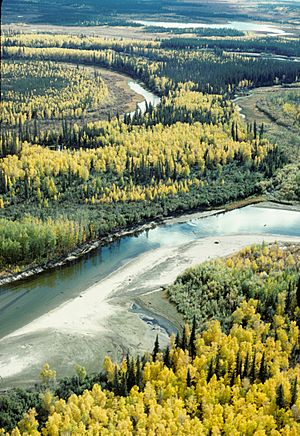Vegetation facts for kids
Vegetation is a fancy word for all the plants growing in a certain area. It includes everything from tiny mosses on rocks to giant trees in a forest. Think of it as the green blanket covering much of our Earth!
When we talk about vegetation, we're usually thinking about the overall plant cover, not specific types of plants. For example, a big field of grass is vegetation, and so is a dense jungle. If you want to talk about the exact kinds of plants, like oak trees or sunflowers, that's called flora.
Vegetation can be found almost everywhere! It could be a huge redwood forest, a swampy mangrove stand near the coast, a wet bog filled with moss, or even the tough plants growing in a hot desert. Even the wheat fields that grow our food, or the lawn in your backyard, are types of vegetation.
Contents
Why is Vegetation Important?
Vegetation is super important for our planet and for us! Here are some reasons why:
- It makes the air we breathe: Plants take in carbon dioxide and release oxygen through a process called photosynthesis. This oxygen is what we need to live!
- It provides food: Almost all the food we eat, directly or indirectly, comes from plants. Think of fruits, vegetables, grains, and even the food animals eat.
- It creates homes: Many animals, from tiny insects to large mammals, live in different types of vegetation. Forests, grasslands, and wetlands are all homes for wildlife.
- It helps the soil: Plant roots hold the soil together, which stops it from being washed away by rain or blown away by wind. This is called erosion control.
- It helps with water: Vegetation can soak up rainwater, helping to prevent floods. It also releases water vapor into the air, which can affect local weather patterns.
Different Types of Vegetation
Vegetation comes in many forms, depending on the climate, soil, and geography of an area. Here are some main types:
- Forests: These are areas with lots of trees growing close together. They can be rainforests (warm and wet), coniferous forests (cold, with needle-leaf trees), or deciduous forests (trees that lose their leaves in autumn).
- Grasslands: These are wide-open spaces covered mostly by grasses. Examples include the savannas of Africa or the prairies of North America. They often have few trees.
- Deserts: These are very dry areas with little rainfall. The vegetation here is specially adapted to survive with very little water, like cacti and succulents.
- Tundra: Found in very cold regions, the tundra has short growing seasons. The vegetation is usually low-growing, like mosses, lichens, and small shrubs.
- Wetlands: These are areas where the land is covered by water for at least part of the year. This includes swamps, marshes, and bogs. Plants here are adapted to wet conditions, like water lilies and cattails.
How Vegetation Changes
Vegetation doesn't stay the same forever. It can change over time due to natural events or human activities.
- Natural changes: Things like wildfires, floods, volcanic eruptions, or even long-term climate changes can cause vegetation to shift. After a disturbance, new plants will often start to grow, slowly changing the area back.
- Human impact: People can also change vegetation. Cutting down forests for farming or building, pollution, and introducing new plant species can all affect the natural vegetation of an area. It's important to manage these changes carefully to protect our planet.
Images for kids
See also
 In Spanish: Vegetación para niños
In Spanish: Vegetación para niños



